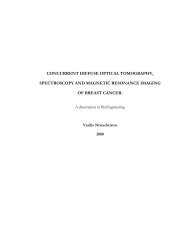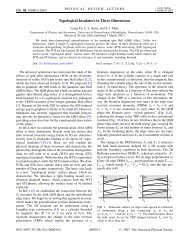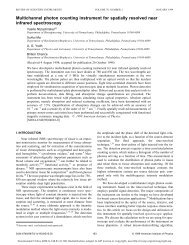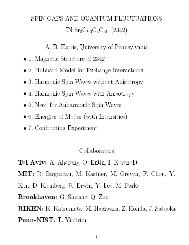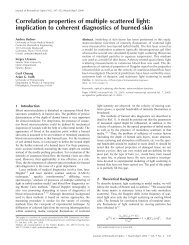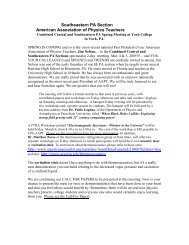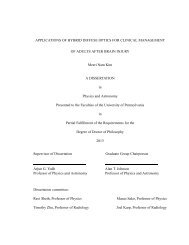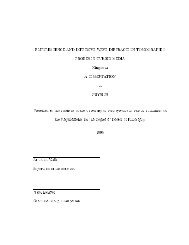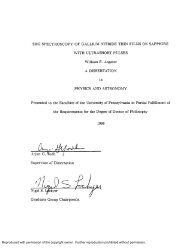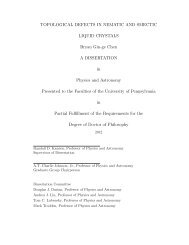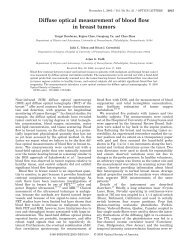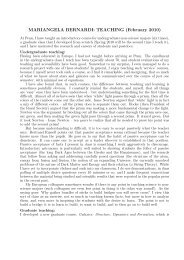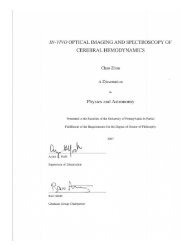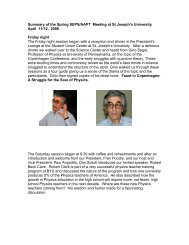View - ResearchGate
View - ResearchGate
View - ResearchGate
Create successful ePaper yourself
Turn your PDF publications into a flip-book with our unique Google optimized e-Paper software.
Brownian Motion of an Ellipsoid<br />
Y. Han, et al.<br />
Science 314, 626 (2006);<br />
DOI: 10.1126/science.1130146<br />
The following resources related to this article are available online at<br />
www.sciencemag.org (this information is current as of June 10, 2008 ):<br />
Updated information and services, including high-resolution figures, can be found in the online<br />
version of this article at:<br />
http://www.sciencemag.org/cgi/content/full/314/5799/626<br />
Supporting Online Material can be found at:<br />
http://www.sciencemag.org/cgi/content/full/314/5799/626/DC1<br />
This article cites 13 articles, 1 of which can be accessed for free:<br />
http://www.sciencemag.org/cgi/content/full/314/5799/626#otherarticles<br />
This article has been cited by 5 article(s) on the ISI Web of Science.<br />
This article appears in the following subject collections:<br />
Physics<br />
http://www.sciencemag.org/cgi/collection/physics<br />
Information about obtaining reprints of this article or about obtaining permission to reproduce<br />
this article in whole or in part can be found at:<br />
http://www.sciencemag.org/about/permissions.dtl<br />
Downloaded from www.sciencemag.org on June 10, 2008<br />
Science (print ISSN 0036-8075; online ISSN 1095-9203) is published weekly, except the last week in December, by the<br />
American Association for the Advancement of Science, 1200 New York Avenue NW, Washington, DC 20005. Copyright<br />
2006 by the American Association for the Advancement of Science; all rights reserved. The title Science is a<br />
registered trademark of AAAS.
REPORTS<br />
temperature differences exist between the day and<br />
night faces of the planet, consistent with a model<br />
in which very little horizontal energy transport<br />
occurs in the planetary atmosphere. Furthermore,<br />
it indicates that the opportunities for direct<br />
extrasolar planetary observations are better than<br />
previously thought, because useful data can be<br />
obtained even in cases where the planetary orbit is<br />
not so fortuitously aligned that the system exhibits<br />
transits or eclipses.<br />
References and Notes<br />
1. D. Deming, S. Seager, L. J. Richardson, J. Harrington,<br />
Nature 434, 740 (2005).<br />
2. D. Charbonneau et al., Astrophys. J. 626, 523 (2005).<br />
3. There is no official terminology for planets that orbit close to<br />
their parent stars. The term “hot Jupiter” is the most<br />
common, although some authors have adopted other terms,<br />
such as “Pegasids,” “Pegasi planets,” or “Roasters.”<br />
4. G. H. Rieke et al., Proc. SPIE 5487, 50 (2004).<br />
5. M. W. Werner et al., Astrophys. J. Suppl. Ser. 154, 1 (2004).<br />
6. K. Horne, Publ. Astron. Soc. Pac. 98, 609 (1986).<br />
7. L. J. Richardson, J. Harrington, S. Seager, D. Deming,<br />
Astrophys. J.; preprint available at http://arxiv.org/abs/<br />
astro-ph/0606096.<br />
8. The passage of an extrasolar planet behind its star, an<br />
eclipse, results in a drop in the total system flux. This allows a<br />
measurement of the absolute flux emerging from the part of<br />
the planet that faces the star (the day side). This is possible<br />
when the orbit is aligned almost edge-on to the line of sight.<br />
9. D. Deming, J. Harrington, S. Seager, L. J. Richardson,<br />
Astrophys. J. 644, 560 (2006).<br />
10. We use the estimator provided by the Spitzer Science<br />
Center, which is based on the DIRBE model described<br />
by (21). Further information on the specific<br />
implementation is given at http://ssc.Spitzer.caltech.<br />
edu/documents/background.<br />
11. R. P. Butler et al., Astrophys. J. 474, L115 (1997).<br />
12. J. Cho, K. Menou, B. Hansen, S. Seager, Astrophys. J.<br />
587, L117 (2003).<br />
13. C.S.Cooper,A.P.Showman,Astrophys. J. 629, L45 (2005).<br />
14. G. W. Henry, S. L. Baliunas, R. A. Donahue, F. C. Fekel,<br />
W. Soon, Astrophys. J. 531, 415 (2000).<br />
15. E. Shkolnik, G. A. H. Walker, D. A. Bohlender, P.-G. Gu,<br />
M. Kürster, Astrophys. J. 622, 1075 (2005).<br />
16. S. Seager et al., Astrophys. J. 632, 1122 (2005).<br />
17. T. Barman, P. Hauschildt, F. Allard, Astrophys. J. 632,<br />
1132 (2005).<br />
18. J. Fortney, M. Marley, K. Lodders, D. Saumon, R. Freedman,<br />
Astrophys. J. 627, L69 (2005).<br />
19. A. Burrows, I. Hubeny, D. Sudarsky, Astrophys. J. 625,<br />
L135 (2005).<br />
20. D. A. Fischer, J. Valenti, Astrophys. J. 622, 1102 (2005).<br />
21. T. Kelsall et al., Astrophys. J. 508, 44 (1998).<br />
22. The usual estimate given for planetary temperatures is<br />
the equilibrium temperature, T eq , defined as the<br />
Brownian Motion of an Ellipsoid<br />
Y. Han, 1 A. M. Alsayed, 1 M. Nobili, 2 J. Zhang, 1 T. C. Lubensky, 1 * A. G. Yodh 1<br />
We studied the Brownian motion of isolated ellipsoidal particles in water confined to two<br />
dimensions and elucidated the effects of coupling between rotational and translational motion. By<br />
using digital video microscopy, we quantified the crossover from short-time anisotropic to longtime<br />
isotropic diffusion and directly measured probability distributions functions for displacements.<br />
We confirmed and interpreted our measurements by using Langevin theory and numerical<br />
simulations. Our theory and observations provide insights into fundamental diffusive processes,<br />
which are potentially useful for understanding transport in membranes and for understanding the<br />
motions of anisotropic macromolecules.<br />
1 Department of Physics and Astronomy, University of Pennsylvania,<br />
209 South 33rd Street, Philadelphia, PA 19104, USA.<br />
2 Laboratoire des Colloides, Verres et Nanomateriaux CNRS-<br />
University Montpellier II, Place E. Bataillon, 34090 Montpellier,<br />
France.<br />
*To whom correspondence should be addressed. E-mail:<br />
tom@physics.upenn.edu<br />
Brownian motion (1), wherein small<br />
particles suspended in a fluid undergo<br />
continuous random displacements, has<br />
fascinated scientists since before it was first<br />
investigated by the botanist Robert Brown in the<br />
early 19th century. The origin of this mysterious<br />
motion was largely unexplained until Einstein's<br />
famous 1905 paper (2) that established a relation<br />
between the diffusion coefficient of a Brownian<br />
particle and its friction coefficient. One year later<br />
(3), Einstein extended the concept of Brownian<br />
dynamics to rotational and other degrees of freedom.<br />
The subsequent study of Brownian motion<br />
and its generalizations has had a profound impact<br />
on physics, mathematics, chemistry, and biology<br />
(4). Because direct detection of translational<br />
Brownian motion is relatively easy, many experiments<br />
elucidating the ideas of translational diffusion<br />
have been carried out. On the other hand, the direct<br />
visualization of rotational Brownian motion has<br />
not been an easy task, and fundamental concepts<br />
about motions of anisotropic macromolecules<br />
remain untested. For this contribution, we used<br />
digital video microscopy to study the Brownian<br />
motion of an isolated ellipsoid in suspension and<br />
thus directly observed the coupling effects<br />
between rotational and translational motion.<br />
Particle anisotropy leads to dissipative coupling<br />
of translational to rotational motion and to<br />
physics first explored by F. Perrin (5, 6). A<br />
uniaxial anisotropic particle is characterized by<br />
two translational hydrodynamic friction coefficients,<br />
g a and g b , respectively, for motion parallel<br />
and perpendicular to its long axis. If a<br />
particle's rotation is prohibited, it will diffuse<br />
independently in directions parallel and perpendicular<br />
to its long axis with respective diffusion<br />
constants of D a = k B T/g a for a either a or b,<br />
where k B is Boltzmann’s constant and T is the<br />
temperature. In general, g a is less than g b (7),<br />
and consequently D a is greater than D b . If<br />
effective temperature of a uniformly bright planet<br />
radiating energy at a rate that balances the irradiation<br />
received from the star. T eq is thus determined by the<br />
stellar effective temperature, T eff , stellar radius, R *<br />
, and<br />
distance of the planet from the star a:<br />
T eq ¼ 1744 KðT eff =6212 KÞðR ∗ =1:57R ⊙ Þ 1 = 2<br />
ða=0:059AUÞ −1 = 2<br />
in the case of u and b with albedo = 0.05. However, in<br />
a proper no-redistribution model, the temperature<br />
distribution is not uniform but rather hottest at the<br />
substellar point and coolest at the limb, and the fullphase<br />
temperature average over the planetary surface is<br />
better approximated by ( 4 / 3) 1 /4T eq . This is the temperature<br />
we adopt, which is 1875 K in this case.<br />
23. This work is based on observations made with the Spitzer Space<br />
Telescope, which is operated by the Jet Propulsion Laboratory,<br />
California Institute of Technology, under contract with NASA.<br />
Support for this work was provided directly by NASA, its Origins<br />
of Solar Systems and Astrophysical Theory programs, as well as<br />
the Astrobiology Institute and Spitzer Science Center. We thank<br />
the personnel of the Spitzer Science Center and its MIPS<br />
instrument, who ultimately made these measurements possible.<br />
15 August 2006; accepted 18 September 2006<br />
Published online 12 October 2006;<br />
10.1126/science.1133904<br />
Include this information when citing this paper.<br />
rotation is allowed, rotational diffusion, characterized<br />
in two dimensions by a single diffusion<br />
coefficient, D q , and associated diffusion time, t q =<br />
1/(2D q ), washes out directional memory and leads<br />
to a crossover from anisotropic diffusion at short<br />
times to isotropic diffusion at times much longer<br />
than t q .Figure1,AandB,presentsnumerical<br />
simulations (8) that illustrate this behavior. Our<br />
experiments, which were restricted to two<br />
dimensions (2D), provide explicit verification of<br />
this behavior and some of its extensions. In<br />
addition, we show that a fundamental property of<br />
systems with dissipatively coupled translation and<br />
rotation is the existence of non-Gaussian probability<br />
density functions (PDFs) for displacements<br />
in the lab frame.<br />
Micrometer-sized PMMA (polymethyl methacrylate)<br />
uniaxial ellipsoids (9) were under strong<br />
quasi–two-dimensional confinement in a thin<br />
glass cell. The choice of 2D rather than 3D for<br />
these studies substantially simplified the experimental<br />
imaging tasks as well as the data<br />
acquisition time and storage requirements. The<br />
choice also ensured that the measured effects<br />
would be large by virtue of the much larger<br />
friction anisotropy in 2D compared with 3D.<br />
The local cell thickness was ~1 mm. It was measured<br />
to within 0.1 mm resolution by comparing<br />
the Michel-Levy chart (10) to the reflected<br />
interference colors produced by the two inner<br />
surfaces under white light illumination on the<br />
microscope (Fig. 1D). To avoid interactions<br />
between ellipsoids, we made the solution very<br />
dilute. The Brownian motion of a single ellipsoid<br />
in water was recorded by a charge-coupled device<br />
(CCD) camera on a videotape at 30 frame/s.<br />
From the image analyses, we obtained data sets<br />
consisting of a particle's center-of-mass positions<br />
Downloaded from www.sciencemag.org on June 10, 2008<br />
626<br />
27 OCTOBER 2006 VOL 314 SCIENCE www.sciencemag.org
REPORTS<br />
x(t n ) = [x(t n ), y(t n )] in the lab frame and its<br />
orientation angles q(t n ) relative to the x axis at<br />
times t n = n(1/30) s, as shown in Fig. 1F. The<br />
orientational resolution is 1°, and spatial resolutions<br />
are 0.5 pixel = 40 nm along the particle's<br />
short axis and only 0.8 pixel along its long axis<br />
because of the superimposed small tumbling<br />
motion. We define each 1/30-s time interval as a<br />
step. During the nth step, the particle's position<br />
changes by dx(t n )=x(t n ) − x(t n−1 ) and its angle<br />
by dq(t n )=q(t n ) − q(t n−1 ).Fromthedataset,we<br />
extract an ensemble of particle trajectories starting<br />
at different times t 0 and ending a time t later.<br />
The total positional and angular displacements<br />
in these trajectories are, respectively, Dx(t) =<br />
x(t + t 0 ) − x(t 0 )andDq(t) =q(t + t 0 ) − q(t 0 ).<br />
We first consider the statistical properties of<br />
q(t), which, as pointed out by Perrin (6), are<br />
independent of translational motions. We<br />
measured data from a 30-min trajectory of a 2.4<br />
mm–by–0.3 mm–by–0.3 mm ellipsoid confined in<br />
an 846-nm-thick cell (Fig. 2A). The inset shows<br />
that the mean-square angular displacement<br />
〈[Dq(t)] 2 〉 equals 2D q t, where the average 〈〉is<br />
over all trajectories with different starting times<br />
t 0 . The mean-square angular displacement has<br />
diffusive behavior over the entire range of<br />
observable times with a rotational time of t q =<br />
1/(2D q ) = 3.1 s. Over the time scales we can<br />
observe, this diffusive behavior is independent<br />
of q 0 . The PDF for Dq(t) was measured to be<br />
Gaussian with variance 2D q t, and the angles q(t)<br />
were measured to be uniformly distributed in<br />
[0,2p].<br />
We now turn to the statistics of translational<br />
motion whose full understanding is facilitated<br />
by the consideration of decomposing the<br />
displacement dx n into its components d ˜x ni<br />
relative to the body frame or dx ni relative to<br />
the fixed lab frame. As shown in Fig. 1C, the<br />
Fig. 1. (A and B) 10,000-step 2D random walk trajectories for an ellipsoid with D a =0.99andD b =0.01<br />
during t q and 100t q , respectively. t q is the time for the ellipsoid to diffuse 1 rad. (A Inset) 10,000-step<br />
trajectory for a sphere with D a = D b =0.5duringt q . The initial positions are represented by a green<br />
ellipse and a sphere. At step times long compared with t q , the coarse-grained 100-step black trajectory in<br />
(B) is similar to that of the random walk of a spherical particle in fig. S1. (C) Representationofan<br />
ellipsoid in the x-y labframeandthex˜-ỹ body frame. The angle between two frames is q(t). The<br />
displacement dx can be decomposed as (dx, dy) or(dx˜, dỹ). (D) True interference color in the reflection<br />
mode of the microscope. (E) Ellipsoid image in the transmission mode. (F) A typical 20-s experimental<br />
trajectory with step 1/30 s. D a /D b = 4.07. Orientations are further labeled with a rainbow color scale. For<br />
example, the purple parts of the trajectory reflect a higher mobility along the y direction, and the red<br />
parts reflect a higher mobility along the x direction.<br />
two are related via a rotation, d ˜x ni = R ij dx nj ,<br />
where the Einstein summation convention on<br />
repeated indicesis understood and R ij =<br />
cosq n sinq n<br />
is the rotation matrix with<br />
−sinq n cosq n<br />
q n =[q(t n−1 )+q(t n )]/2. In practice, choosing<br />
q n = q(t n−1 )orq n = q(t n ) has little effect on our<br />
results because q barely changes during 1/30 s.<br />
We can construct total body-frame displacements<br />
by summing over displacements in each<br />
step, ˜xðt n Þ¼∑ n k¼1 d ˜x k , and from ˜x (t n)wecan<br />
construct body-frame displacements for trajectories<br />
of duration t at starting time t 0 via D ˜x (t)=<br />
˜x (t + t 0 ) − ˜x (t 0 ).<br />
Mean-square displacements (MSDs) in the<br />
body frame and in the lab frame were averaged<br />
over all trajectories with different initial angle<br />
q 0 ≡ q(t 0 ) (Fig. 2A). They are all diffusive with<br />
〈[D ˜x (t)] 2 〉 =2D a t, 〈[Dỹ (t)] 2 〉 =2D b t,and<br />
〈[Dx(t)] 2 〉 = 〈[Dy(t)] 2 〉 =(D a + D b )t ≡ 2 Dt. The<br />
full average 〈〉for any observable A can be viewed<br />
as an ensemble average of trajectories at fixed<br />
q 0 followed by a second average over all q 0 : 〈A〉 =<br />
[〈A〉 q0 ] av = 1<br />
2p ∫2p 0 dq 0〈A〉 q0 .<br />
A particle with a given initial angle will<br />
diffuse more rapidly along its long axis than<br />
along its short axis. As time progresses,<br />
however, memory of its initial direction is lost,<br />
and diffusion becomes isotropic. Thus, averages<br />
over trajectories at fixed q 0 should exhibit a<br />
crossover from early-time anisotropic to latetime<br />
isotropic diffusion. Our measurements with<br />
q 0<br />
= 0 of the time-dependent diffusion coefficients<br />
D xx (t) =〈[Dx(t)] 2 〉 0 /(2t) andD yy (t) =<br />
〈[Dy(t)] 2 〉 0 /(2t) = 〈½DxðtÞŠ 2 〉p<br />
2<br />
/(2t) provide direct<br />
verification of this crossover (Fig. 2B): At t > t q , D xx equals D yy equals D.<br />
The anisotropic-to-isotropic crossover was<br />
calculated in 3D by Perrin (6) and is mentioned<br />
in qualitative terms in a 3D simulation (11). We<br />
calculate the properties of this transition in 2D<br />
within the Langevin formalism and compare<br />
them with experiment. Because our time scales<br />
are much larger than the momentum relaxation<br />
times of a micrometer-sized particle in<br />
water (I/g rot ~ m/g ~10 −7 s), we can ignore inertial<br />
terms. The Langevin equations for displacement<br />
and angle in the lab frame in the<br />
presence of external forces described by a<br />
Hamiltonian H are<br />
∂ t x i ¼ −G ij ðqÞ ∂H<br />
∂x j<br />
þ x i ðtÞ<br />
∂ t q ¼ −G q<br />
∂H<br />
∂q þ x q<br />
ð1aÞ<br />
ð1bÞ<br />
where i = x,y for 2D and G ij = g −1 ij is the mobility<br />
tensor, which can be expressed in terms of<br />
the unit vector n(t) ≡ n[q(t)] specifying the direction<br />
of the local anisotropy axis as G ij (t)=G b d ij +<br />
DGn i (t)n j (t) = Gd ij + DGM ij [q(t)]/2, where G =<br />
(G a + G b )/2, DG = G a − G b , and M ij (q) =<br />
cos 2q sin 2q<br />
. x<br />
sin 2q −cos 2q q (t) and x i (t) are ran-<br />
Downloaded from www.sciencemag.org on June 10, 2008<br />
www.sciencemag.org SCIENCE VOL 314 27 OCTOBER 2006 627
REPORTS<br />
dom noise sources with zero mean and respective<br />
variances, 〈x q (t)x q (t′)〉 =2k B TG q d(t − t′) =<br />
2D q d(t − t′)and〈x i (t)x j (t′)〉 q(t) =2k B TG ij [q(t)]d(t − t′),<br />
dictated by the Einstein relation or equivalently<br />
by the requirement that thermal equilibrium be<br />
reached at long times. We retain H in Eq. 1 even<br />
though the external forces are zero in our<br />
experiments to emphasize that the mobilities G ij<br />
and G q relating velocity and angular velocity to<br />
force and torque, respectively, determine the<br />
variances of the random noise sources. x q (t)<br />
obeys Gaussian statistics at all times, as does x i (t)<br />
for a fixed angle q(t). The average 〈A〉 q0 of any<br />
measurable quantity is equivalent to the average<br />
of A over both x i (t)andx q (t)atfixedq 0 .<br />
Because there are no external forces in our<br />
experiments, we can set ∂H/∂x =0and∂H/∂q =0.<br />
Equation 1b for q(t) is simply the Langevin equation<br />
for 1D diffusion. It yields a time-independent<br />
diffusion coefficient D q = 〈[Dq(t)] 2 〉/(2t), a<br />
Gaussian PDF for Dq(t) with variance 2D q t,<br />
and consequently 〈cosnDq(t)〉 = Re〈e inDq(t) 〉 =<br />
cosnq 0 e −n2 D qt . From this we can calculate (8)the<br />
time-dependent displacement diffusion tensor<br />
for fixed q 0 :<br />
D ij ðt,q 0 Þ¼h½Dx i ðtÞŠ½Dx j ðtÞŠi q0<br />
=ð2tÞ<br />
¼ Dd ij þ DD t 4 ðtÞ<br />
M ij ðq 0 Þ<br />
2 t<br />
ð2Þ<br />
where DD ≡ D a − D b and t n (t) ≡∫ 0 t dt′e −nDqt′ =<br />
(1 − e −nDqt )/(nD q ). D xx (t,0) and D yy (t,0)<br />
quantitatively match experimental results for<br />
q 0 = 0 as shown in Fig. 2B, with D a , D b ,andD q<br />
equal to their values obtained from Fig. 2A. The<br />
average of D ij (t, q 0 ) in Eq. 2 over initial angles q 0<br />
yields D xx = D yy = D, inagreementwiththe<br />
MSDs of x and y in Fig. 2A. The 3D counterpart,<br />
D xx = D yy = D zz =(D a + D b + D c )/3, is widely<br />
used in dynamic light scattering (12).<br />
Unlike spheres, anisotropic particles have<br />
anisotropic friction coefficients that are responsible<br />
for the coupling of translation and rotation.<br />
This coupling leads to nontrivial mixed correlation<br />
functions such as<br />
〈Dx i Dx j e inq 〉=t ¼<br />
½2D þ DDA ðnÞ<br />
ij ðtÞ=2Še inq0 − n2 D qt<br />
ð3Þ<br />
<br />
where A (n) ij(t)=e i2q 1 −i<br />
t (4+4n) + e −i2q t<br />
−i −1 (4−4n)<br />
<br />
1 i<br />
. Equation 3 is obtained from our<br />
i −1<br />
Langevin formalism (8). Experimental results<br />
agree well with these theoretical predictions and<br />
deviate from the theoretical dashed curves<br />
obtained assuming translational and rotational<br />
motion are decoupled (Fig. 2C).<br />
Transforming Eq. 1a into the body frame<br />
at ∂H/∂x = 0, we obtain<br />
∂ t ˜x i ¼ ˜x i ðtÞ ¼R ij ½qðtÞŠx j ðtÞ<br />
ð4Þ<br />
The probability distribution of ˜xi(t), which can<br />
be calculated directly from its definition and the<br />
properties of x i (t), is a Gaussian with zero mean<br />
and variance 〈˜x i ˜xj 〉 =2k B T ˜G ij d(t − t′), where ˜G ij is<br />
a q(t)-independent diagonal matrix with components<br />
˜G xx = G a and ˜G yy = G b .Thus,〈(D ˜x i ) 2 〉<br />
equals 2D i t,whereD i =(D a , D b ), in agreement<br />
with the experimental data in Fig. 2A. Because ˜x i<br />
is Gaussian, the PDF for body-frame displacements<br />
D ˜x i (t) is Gaussian at all times:<br />
x2<br />
f ðx,tÞ¼ 1<br />
D˜x<br />
pffiffiffiffiffi<br />
e−2s 2 i ðtÞ<br />
i<br />
2p si ðtÞ<br />
ð5Þ<br />
where s i 2 (t)=2D i t. Our measurements confirm<br />
this behavior in fig. S1. For our quasi-2D<br />
sample, the ellipsoid's friction and diffusion<br />
tensors are different at different heights within<br />
the cell (13). Therefore, the PDF of D ˜x i should<br />
be an average of Gaussian PDFs with<br />
different variances. However, the interference<br />
color from the ellipsoid changed very<br />
little throughout the course of our experiment;<br />
from this result we estimate that the ellipsoid<br />
remains within 50 nm of the midplane of the<br />
cell and that the non-Gaussian effects are too<br />
small to be observable as is confirmed by our<br />
measurements.<br />
Although the statistics of displacements in the<br />
body frame are Gaussian, those in the lab frame<br />
are not because of coupling between translation<br />
and rotation (14). Prager (15) calculated the<br />
non-Gaussian concentration for averaged initial<br />
angles in a particular geometry in three dimensions.<br />
The lab-frame noise, x i (t)=R −1 ij [q(t)] ˜x i (t), is<br />
a nonlinear function of the independent noises<br />
x q (t) and ˜x i (t). Thus, although its probability<br />
distribution is Gaussian for fixed q(t) and thus<br />
fixed x q (t), its distribution averaged over x q (t) is<br />
non-Gaussian, as is that for Dx i (t). At short<br />
times, the lab- and body-frame displacements<br />
are equal, and the PDF for Dx i (t) is Gaussian<br />
because that for D ˜x i (t) is. Directional information<br />
is lost at times greater than t q . Therefore,<br />
at long times, Dx(t) is a sum of displacements<br />
from ~t/t q statistically independent steps, and<br />
the central limit theorem implies that its PDF is<br />
Gaussian. Thus at fixed q 0 , we expect deviation<br />
from Gaussian behavior to vanish at t = 0 and<br />
t = ∞ and to reach a maximum at times of<br />
order t q .<br />
The simplest manifestations of non-Gaussian<br />
behavior are the nonzero values of the fourth- or<br />
higher-order cumulants of lab-frame displacements,<br />
which can be calculated (8) fromour<br />
Langevin theory. For example, the fourth<br />
cumulant of Dx(t) for fixed initial orientation is<br />
C ð4Þ<br />
q 0<br />
ðtÞ ¼h½DxðtÞŠ 4 i q0<br />
−3h½DxðtÞŠ 2 i 2 q 0<br />
¼ 1 n<br />
2 ðDDÞ2 3½t q t − t q t 4 ðtÞ − t 4 ðtÞ 2 Šþ<br />
o<br />
½t q t 4 ðtÞ − t q t 16 ðtÞ − 3t 4 ðtÞ 2 Šcos4q 0<br />
ð6Þ<br />
Downloaded from www.sciencemag.org on June 10, 2008<br />
Fig. 2. (A) MSDsalonga, b, x, andy axes. (Inset) Angular MSD. All curves<br />
have diffusive behavior (º t), and corresponding diffusion coefficients D =<br />
MSD/(2t) shown in the figure are from best fits. (B) Diffusion coefficients D in<br />
the lab frame. The initial orientation of each trajectory was chosen to be along<br />
the x axis (q 0 = 0), so that D xx and D yy change from D a and D b to D,<br />
p<br />
respectively, over time interval t q . Symbols, experiment; error bars º<br />
ffiffi t . Solid<br />
curves, Eq. 2 when q 0 =0.(C) Mixed correlations of translational p displacements<br />
and orientation. Symbols, experiment. Error bars º<br />
ffiffi t . Solid curves, theoretical<br />
results from Eq. 3 for n = 2. Dashed curves, reference uncorrelated<br />
averages 〈Dx 2 〉〈cos2q〉/t, 〈Dy 2 〉〈cos2q〉/t, and2〈DxDy〉〈sin2q〉/t =0.<br />
628<br />
27 OCTOBER 2006 VOL 314 SCIENCE www.sciencemag.org
REPORTS<br />
This function vanishes as t 2þs2 ,wheres 2 >0,as<br />
t → 0 and grows linearly in t as t → ∞. The<br />
non-Gaussian parameter,<br />
pðt; q 0 Þ ¼<br />
¼<br />
C ð4Þ<br />
q 0<br />
ðtÞ<br />
3h½DxðtÞŠ 2 i 2 q 0<br />
C ð4Þ<br />
q 0<br />
ðtÞ<br />
3½2 Dt þ DDt 4 ðtÞcos2q 0 Š 2<br />
ð7Þ<br />
vanishes with t s2 for t → 0andast −1 as t → ∞.<br />
The angle-averaged non-Gaussian parameter,<br />
C ð4Þ ðtÞ<br />
pðtÞ ¼<br />
3〈½DxðtÞŠ 2 〉 2<br />
¼ DD2 t q ½t − t 4 ðtÞŠ<br />
8D 2 t 2<br />
t→0 ðD a =D b − 1Þ 2<br />
!<br />
2ðD a =D b þ 1Þ 2<br />
ð8Þ<br />
ð9Þ<br />
where C (4) (t) = 〈[Dx(t)] 4 〉 − 3〈[Dx(t)] 2 〉 2 , approaches<br />
a constant as t →0 and vanishes as t −1<br />
as t → ∞. Because statistics in the body frame<br />
are Gaussian, the body-frame non-Gaussian<br />
parameter p b (t) is zero.<br />
Equations 7 and 8 are confirmed numerically<br />
in Fig. 3A. Experimental measurements of both<br />
p(t,q 0 )and p (t) have poor statistics at large t because<br />
their errors grow as t 3/2 . Nevertheless, we<br />
were able to extrapolate to the t → 0limitof<br />
p (t) in seven samples with different aspect<br />
ratios and to confirm Eq. 9 in the Fig. 3A inset.<br />
Figure 3A confirms our qualitative expectations<br />
about the non-Gaussian parameter p in different<br />
frames and for different types of averages,<br />
specifically: (i) In the ensemble with fixed q 0 ,<br />
the non-Gaussian parameter vanishes for t > t q and reaches a maximum when t ~ t q ;<br />
(ii) in the ensemble that averages over q 0 ,the<br />
non-Gaussian parameter is a maximum at t =0<br />
and vanishes for t >> t q ; and (iii) larger D a /D b<br />
causes larger non-Gaussian effects.<br />
It is clear from Eqs. 6 to 9 that non-Gaussian<br />
behavior originates in particle anisotropy and<br />
vanishes when DD vanishes. Thus, non-Gaussian<br />
effects for anisotropic particles diffusing in 3D<br />
with stick boundary conditions should be small<br />
because 1 < D a /D b = g b /g a D b , i.e., for particles with a high<br />
aspect ratio confined in quasi-2D (in our case,<br />
D a /D b reaches about 4) or for some molecules<br />
with slip boundary conditions.<br />
Lastly, we consider the lab-frame PDF for<br />
Dx(t). The expectation is that these PDFs at<br />
fixed q 0 will be non-Gaussian and exhibit<br />
maximum deviations from Gaussian behavior<br />
at times of order t q .Wehaveverifiedthatthisis<br />
the case within our statistical errors, but the<br />
deviations are very small. The lab-frame PDF<br />
averaged over q 0 shows more striking deviations<br />
from Gaussian behavior (8), particularly<br />
as t → 0:<br />
f Dx ðxÞ ¼hd½x − DxðtÞŠi !<br />
t→0 Z 2p<br />
0<br />
dq 2s 2 ðqÞ<br />
pffiffiffiffiffi<br />
2p 2p sðqÞ<br />
e −<br />
x2<br />
ð10Þ<br />
where s 2 (q) =s a 2 cos 2 q + s b 2 sin 2 q with s i 2 =<br />
2D i t. The physical meaning of Eq. 10 is apparent.<br />
When t → 0, the orientation q does not<br />
change during the displacement. Those Dx with<br />
the same q 0 follow a Gaussian distribution with<br />
s = s(q 0 ) because the hydrodynamic drag coefficient<br />
g(q 0 ) is a constant. Averaging Gaussian<br />
PDFs with different q 0 over [0,2p] yields a non-<br />
Gaussian PDF as shown in Eq. 10.<br />
Experimental angle-averaged PDFs of labframe<br />
displacement are shown (Fig. 3B) at time<br />
intervals of t = 0.1 s. The system's isotropy is<br />
confirmed by f Dx (x) =f Dy (x). Interestingly, there<br />
are more tiny and large steps and fewer middlesized<br />
steps than there are in a Gaussian<br />
distribution (fig. S2). This PDF agrees with Eq.<br />
10 very well with no free parameters. We measured<br />
the PDFs of 15 samples with different aspect<br />
ratios at different confinements. All agreed<br />
with Eq. 10. When D a /D b < 2.5, the measured<br />
non-Gaussian PDF becomes indistinguishable<br />
from a Gaussian distribution.<br />
The most common experimental probes<br />
typically measure only second moments, from<br />
which diffusion coefficients can be extracted,<br />
that provide no information about non-Gaussian<br />
behavior. For example, dynamic light scattering<br />
(12, 18) and nuclear magnetic resonance (NMR)<br />
(19) measure q 0 -averaged translational diffusion<br />
coefficients of anisotropic constituents; and<br />
NMR (19), fluorescence depolarization (20),<br />
electric birefringence (21), dichroism (22), and<br />
depolarized dynamic light scattering (19) measure<br />
rotational diffusion coefficients. In principle,<br />
some of these probes, light scattering in particular,<br />
could provide a measure of C (4) (t) t→0<br />
!<br />
3(DD) 2 t 2 /2 and higher moments, but we are not<br />
aware of any such measurements. Certainly, the<br />
non-Gaussian effects would be very small,<br />
especially for particles in 3D where D a /D b
REPORTS<br />
experience slip boundary conditions and thus<br />
have a large ratio of g a to g b .<br />
References and Notes<br />
1. E. Nelson, Dynamical Theories of Brownian Motion<br />
(Princeton Univ. Press, Princeton, NJ, 1972).<br />
2. A. Einstein, Ann. Phys. 17, 549 (1905).<br />
3. A. Einstein, Ann. Phys. 19, 289 (1906).<br />
4. E.g., W. T. Coffey, Y. P. Kalmykov, T. J. Waldron, The<br />
Langevin Equation: With Applications to Stochastic<br />
Problems in Physics, Chemistry and Electrical Engineering<br />
(World Scientific, Singapore, ed. 2, 2004).<br />
5. F. Perrin, J. Phys. Radium V, 497 (1934).<br />
6. F. Perrin, J. Phys. Radium VII, 1 (1936).<br />
7. J. Happel, H. Brenner, Low Reynolds Number Hydrodynamics<br />
(Kluwer, Dordrecht, Netherlands, 1991).<br />
8. See the Supporting Online Materials of Science.<br />
9. C. C. Ho, A. Keller, J. A. Odell, R. H. Ottewill, Colloid<br />
Polym. Sci. 271, 469 (1993).<br />
10. N. H. Hartshorne, A. Stuart, Crystals and the Polarising<br />
Microscope (Edward Arnold, London, ed. 4, 1970).<br />
11. R. Vasanthi, S. Ravichandran, B. Bagchi, J. Chem. Phys.<br />
114, 7989 (2001).<br />
12. B. J. Berne, R. Pecora, Dynamic Light Scattering (Dover,<br />
New York, 2000).<br />
13. S. Bhattacharya, J. Blawzdziewicz, E. Wajnryb, J. Fluid<br />
Mech. 541, 263 (2005).<br />
14. M. Doi, S. F. Edwards, in The Theory of Polymer Dynamics<br />
(Oxford Univ. Press, Oxford, 1986), p. 300.<br />
15. S. Prager, J. Chem. Phys. 23, 2404 (1955).<br />
16. P. G. Saffman, M. Delbruck, Proc. Natl. Acad. Sci. U.S.A.<br />
72, 3111 (1975).<br />
17. C. M. Hu, R. Zwanzig, J. Chem. Phys. 60, 4354 (1974).<br />
18. D. W. Schaefer, G. B. Benedek, P. Schofield, E. Bradford,<br />
J. Chem. Phys. 55, 3884 (1971).<br />
19. W. Eimer, J. R. Williamson, S. G. Boxer, R. Pecora,<br />
Biochemistry 29, 799 (1990).<br />
20. T. Tao, Biopolymers 8, 609 (1969).<br />
21. P. J. Hagerman, Biopolymers 20, 1503 (1981).<br />
22. S. Diekmann, W. Hillen, B. Morgeneyer, R. D. Wells,<br />
D. Porschke, Biophys. Chem. 15, 263 (1982).<br />
23. We are grateful to M. Goulian for a careful reading of<br />
this manuscript. This work is supported by the MRSEC<br />
grant DMR-0520020 and NSF grant DMR-0505048.<br />
Supporting Online Material<br />
www.sciencemag.org/cgi/content/full/314/5799/626/DC1<br />
Materials and Methods<br />
SOM Text<br />
Figs. S1 to S5<br />
References<br />
18 May 2006; accepted 15 September 2006<br />
10.1126/science.1130146<br />
a-Hydroxy and a-Amino Acids<br />
Under Possible Hadean, Volcanic<br />
Origin-of-Life Conditions<br />
Claudia Huber 1 and Günter Wächtershäuser 2 *†<br />
To test the theory of a chemoautotrophic origin of life in a volcanic, hydrothermal setting, we explored<br />
mechanisms for the buildup of bio-organic compounds by carbon fixation on catalytic transition metal<br />
precipitates. We report the carbon monoxide–dependent formation of carbon-fixation products,<br />
including an ordered series of a-hydroxy and a-amino acids of the general formula R-CHA-COOH<br />
(where R is H, CH 3 ,C 2 H 5 ,orHOCH 2 and A is OH or NH 2 ) by carbon fixation at 80° to 120°C, catalyzed by<br />
nickel or nickel,iron precipitates with carbonyl, cyano, and methylthio ligands as carbon sources, with<br />
or without sulfido ligands. Calcium or magnesium hydroxide was added as a pH buffer. The results<br />
narrow the gap between biochemistry and volcanic geochemistry and open a new gateway for the<br />
exploration of a volcanic, hydrothermal origin of life.<br />
The theory of a volcanic, hydrothermal,<br />
chemoautotrophic origin of life postulates<br />
a locally and temporally coherent, evolvable<br />
system of autocatalytic, synthetic carbonfixation<br />
pathways, catalyzed by inorganic transition<br />
metal precipitates (1–4) and generating low<br />
molecular weight organic compounds from<br />
highly oxidized precursors. Here, this system<br />
of pathways is termed “pioneer metabolism.” In<br />
accordance with the principle of metabolic continuity,<br />
the theory assumes a step-by-step evolutionary<br />
changeover by evolution of ligand<br />
feedback from racemic ligands of the inorganic<br />
transition metal precipitates to homochiral metalloenzymes<br />
of extant organisms (3, 4). In a continuing<br />
effort to establish an experimental<br />
grounding for this hypothesis, we experimentally<br />
explored the viability of volcanic, hydrothermal<br />
carbon-fixation pathways using CO and CN – as<br />
carbon sources.<br />
1 Department of Organic Chemistry and Biochemistry,<br />
Technische Universität München, Lichtenbergstraße 4,<br />
D-85747 Garching, Germany.<br />
2 Weinstraße 8, D-80333<br />
München, Germany.<br />
*Present address: 209 Mill Race Drive, Chapel Hill, NC<br />
27514, USA.<br />
†To whom correspondence should be addressed. E-mail:<br />
gwmunich@yahoo.com<br />
We chose Ni or Ni,Fe precipitates as catalytic<br />
transition metals because of the catalytic roles of<br />
these biometals (as sulfide or hydroxide complexes)<br />
in our previous experiments (5, 6); (Ca,<br />
Mg)(OH) 2 as source for hydroxy ligands and for<br />
buffering against acidification; Na 2 SorCH 3 -SNa<br />
as sources for sulfido or methylthio ligands; and<br />
CO and KCN as sources for carbonyl and cyano<br />
ligands in accordance with extant [Fe,Ni]- and<br />
[Fe,Fe]-hydrogenases (7).<br />
The reaction conditions are listed in Table<br />
1. Unless stated otherwise, the experiments were<br />
carried out in a slurry with 10 ml of H 2 Oand<br />
13 C-labeled KCN (8). The alkaline pH range is<br />
in agreement with the pH requirement of peptide<br />
synthesis (6). The range of reaction temperatures<br />
was chosen in agreement with previous<br />
experiments (5, 6) and within the range of growth<br />
temperatures of hyperthermophiles. The CO gas<br />
pressure of 1 bar was chosen as in previous<br />
experiments (5, 6) and combined with a reaction<br />
time of 10 days (run 1). In other runs, the reaction<br />
time was shortened (and product yields<br />
increased) by an increase of CO gas pressure.<br />
The pH was measured at the end of the reaction.<br />
Products in the supernatant were analyzed after<br />
freeze-drying by gas chromatography–mass spectroscopy<br />
(GC-MS).<br />
a-Hydroxy and a-amino acids as main<br />
products (Table 1) constitute ordered series defined<br />
by the general formula R-CHA-COOH,<br />
where R is H, CH 3 ,CH 3 -CH 2 ,orHO-CH 2 and<br />
AisOHorNH 2 . Temperature increase correlates<br />
positively with product yield and with the<br />
ratio of amino acids to hydroxy acids. The<br />
replacement of H 2 ObyD 2 O leads to deuterated<br />
products. With 13 C-labeled KCN, we discriminated<br />
cyano ligands from CO (and, optionally,<br />
methylthio) ligands as the carbon source. The<br />
resulting isotopomers revealed a rich and<br />
complex system of pathways involving allcyano,<br />
all-noncyano, and combined cyano/noncyano<br />
ligands, as exemplified by ratios of<br />
12 C 3 : 13 C 3 isotopomers for lactate and alanine.<br />
The contribution by noncyano pathways correlates<br />
positively with a decrease in CO gas<br />
pressure and an increase in temperature. This<br />
multiplicity of pathways may facilitate metabolic<br />
evolution and a stepwise changeover from a<br />
Ni-dependent use of CO and/or cyano ligands<br />
without energy coupling to a sole use of<br />
CO 2 with energy coupling. We also detected<br />
a-hydroxy-n-valeric acid (run 4, 0.005 μmol),<br />
a-hydroxy-i-valeric acid (runs 4 and 5, trace<br />
amounts), and a-amino-n-valeric acid (run 4,<br />
trace amount). The progressive chain elongation<br />
suggests long-chain a-hydroxy or a-amino acids<br />
as primordial lipids.<br />
Added 15 N-NH 3 enters the amino acids,<br />
which suggests the participation of a pool of<br />
ammonia. The replacement of KCN in run 3<br />
by glycine and alanine generated a-hydroxy<br />
acids at very low rates. This means that a-<br />
amino and a-hydroxy acids are mainly competitive<br />
products and, to a minor extent, consecutive<br />
products. The detection of glycine<br />
amide by high-performance liquid chromatography<br />
(HPLC)–MS (8) suggests carboxamides as<br />
intermediates between CN and COOH groups.<br />
The detection of pyruvate (runs 3, 4, 5, and 10)<br />
having a similar isotopomer ratio as lactate and<br />
alanine suggests a-keto and a-imino groups as<br />
intermediates.<br />
Acetate, propionate, and butyrate (in varying<br />
isotopomer ratios) have been detected with yields<br />
decreasing in that order. The detected ethylene<br />
Downloaded from www.sciencemag.org on June 10, 2008<br />
630<br />
27 OCTOBER 2006 VOL 314 SCIENCE www.sciencemag.org



